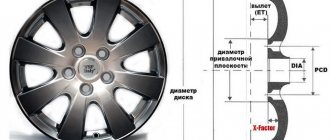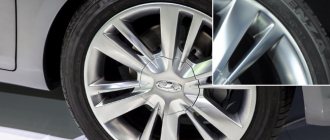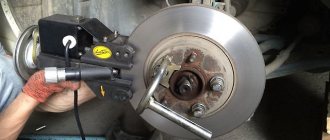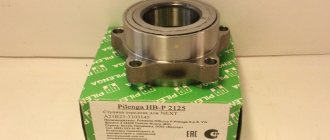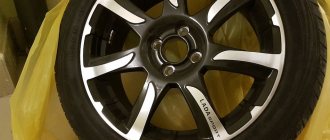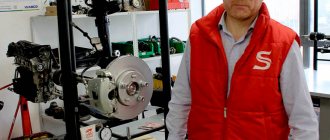About bolts. In the photo there are two types of bolts: “short” and “long”.
“Short” ones are intended for fastening wheels on stamped-welded disks, and “long” ones are for fastening cast and forged disks. Bolts for “stampings” have a shorter threaded part and a smaller bolt head compared to long ones.
Wheel bolts are used by European car manufacturers. Nuts are used in the Japanese and Korean automotive industries. When choosing mounting elements, you should have an idea of their technical features.
Types of fasteners
Here are the types of fasteners needed for alloy wheels:
- Bolts are metal rods with a screw thread at the end. Used to connect detachable elements.
- Nuts are round-shaped parts designed to fasten elements by screwing a metal die onto threaded rods.
Steel, aluminum or titanium alloys are used to produce products.
Titanium bolts are distinguished by high quality indicators. Black bolts for alloy wheels are made from steel with the addition of molybdenum or steel with a chrome or nickel coating.
Choosing bolts for alloy wheels
Often a car is purchased with standard stamped wheels. The natural desire of every car owner is to bring his “iron horse” to perfection.
Therefore, replacing stamped discs with sophisticated cast ones is done quite often. But to install them you need new bolts for the disks, because the old ones will no longer fit here. More precisely, you will need longer bolts.
It is better to purchase bolts for alloy wheels immediately with the wheels. So don't forget about them when making a purchase. Firstly, this way you will save yourself from frequent shopping trips, and secondly, you will be sure that the bolts fit your discs exactly.
There are very, very many types and types of bolts. There are a huge number of differences among them. This is another reason why the selection of alloy wheels for a car should be carried out simultaneously with the selection of bolts for them. Bolts can vary not only in length, but also in the material from which they are made: ferrous metal or steel.
Moreover, the steel can be coated with either a layer of chromium and nickel, or molybdenum.
In purely external terms, chrome-plated bolts are the most aesthetically correct. Because of this, they have become more widely used. Most car owners, when purchasing these particular fasteners, believe that they made the right choice, because the appearance of the car clearly wins. And it is believed that the chrome coating will help protect the bolt from corrosion and other damage. In fact, these alloy wheel bolts have about the same service life as other types of fasteners. And, therefore, this choice is not the most optimal.
Corrosion of the metal from which the disc bolts are made is their main problem. And, unfortunately, neither chrome nor nickel coating can save you from this “infection”. Therefore, you should not be seduced by the beautiful and shiny appearance of the product.
Most motorists believe that bolts without a “fashionable” coating will not “shine.”
In fact, any other fastening materials have an equally attractive appearance at least during the first year of operation.
When choosing bolts for alloy wheels, be guided by their main characteristics: length, bolt width and thread size. Experts advise choosing a bolt length such that when tightened, it makes seven to nine turns, and no less!
You can determine the optimal bolt length in the following ways. First: just screw the wheel on with a bolt, thereby determining whether it suits you or not. But usually it is prohibited to do this in a store before purchasing the product.
Second: when you unscrew the old bolt, count the number of turns. Then divide the resulting number by the length of the bolt. This way you will know what length of bolts for alloy wheels you need to purchase. In fact, there is nothing difficult in choosing and installing high-quality products, so all this can be done without the involvement of specialists, having completed all the work with no less quality. The main thing is to follow these simple rules, and everything will work out in the best possible way.
Characteristics of bolts and nuts
Bolts and nuts differ in design features, so the choice is determined by the type of disk. The stamped disc is made from a durable type of steel. Moreover, it has a small thickness at the point of attachment to the central part of the rotating part. For an optimal connection, the bolt and nut must have a flat surface. The composition of cast wheels includes relatively light alloys. They have reduced reliability characteristics. The fastening system of the products is made in the form of a cone.
Thread
When purchasing bolts, you should pay attention to the threaded part. Not all elements have the same thread pitch. More often there are hardware with a thread pitch of 1.25 and 1.5 mm with a diameter of 12 or 14 mm. It is recommended to purchase new wheel bolts complete with rims or take into account the requirements of the car manufacturer's instructions.
Thread length
To select a bolt of the required length, the easiest way is to try it on site. This technique does not work if the bolt is coated with a coating that is difficult to scratch. Then another option will do; you will need to count the number of revolutions when unscrewing the old bolt. Next, the length of the threaded pin is divided by the resulting figure. The result will be the required length of the fastener.
By size, fasteners are divided into:
- short - used for fixing stamped disk products;
- long - used for tire mounting of alloy wheels.
Pressing surface
In accordance with the classification by landing zone, fasteners are distinguished:
- with a spherical connecting part;
- with a cone-shaped clamping part. Models are produced with and without gaps in the pressure zone. The size of the headrests is 1.3 millimeters.
Many motorists wonder what would be most suitable - a cone or a sphere. In each individual case, in order to select bolts for alloy wheels, it is recommended to seek help from a professional. He will advise what will be better.
Trade marks
Depending on the volume of your orders per month, we offer our clients the following prices:
Wholesale 1. – for orders from 70,000 to 170,000 rubles. Wholesale 2. – for orders from 170,000 to 400,000 rubles. Wholesale 3. – for orders over 400,000 rubles. Wholesale 4. – VIP price for individual contracts. Retail - Price for retail sales and small single purchases.
All prices are indicated including VAT in Russian rubles. You see prices according to your access level.
I think a serious tuning project should start with the wheels.
I have always really liked the design of the wheels standard installed on the SKODA Octavia Sport modification (1.8 turbo, 20 hp, 150 hp...). These are the ones I decided to install on my Beauty.
A long search followed... I called many people while I was looking. This model of rims is not often put up for sale, and if it happens, it is immediately swept away. And so I dial another phone number, and in response to my already formulaic question I hear an unusual phrase for me: “In stock. Come and take a look. Only, the wheels are not from the sport version of the Octavia, but from the RS version.” They have the same manufacturer and design, the same alloy and 5x100 bolt pattern, but the rim size is no longer 6.5x16″, but 7x17″.
I went to look. I measured them three more times in all respects. It looks like they’ll fit in, even if it’s right next to each other. They look quite alive. And the price is quite reasonable. There's just one thing that's a little alarming - the color is not native. Why were they repainted? Was the previous owner simply not happy with the color, or was painting an inevitable necessity after the renovation? Let's find out now!
I buy beautiful cars and take them... no, not home, but straight to the tire shop. There we remove the tires and check the evenness and balance of the rims. Everything is absolutely perfect. Now I can sleep peacefully and be confident that I made a good purchase. And here they are in my garage!
The next question is: “How to screw them on?” It's easier with the rear ones. The rear axle of the VAZ-2108 is fitted with a rear hub from a Skoda Octavia.
But what about the front ones? The Great Internet turned out to be helpless in solving this problem; I had to find a solution myself. Install spacers - I’ll increase the track and get tired of changing wheel bearings, changing the hub - on the hubs I studied with a 5x100 bolt pattern, there is a different splined part for installing an outer CV joint. I also couldn’t find any suitable “hub-CV joint assembly” solutions. And with the same splines - only 4x98 and 4x100. But the latter have a slightly larger flange.
I took 2 hubs from a Chevrolet Aveo, aka Daewoo Kalos, aka ZAZ Vida, pressed out the studs, welded (!) their holes, leveled the contact plane of the brake disc, and then, it’s already clear, I drilled new holes (5x100) and tapped them thread 14x1.5.
In the photographs, the car is disassembled, and the suspension springs are unloaded and completely released. In the future I plan to significantly lower the suspension and upgrade the wings with arches.
The foundation for this tuning project can be considered laid. Next will be brakes, suspension,... But these are other topics...
What is a bolt pattern
Bolt pattern - indicators indicating the correspondence of the sizes of bolts and disks. The information is useful for searching for disk products. Based on the data, identical holes are found on new disks. The number of recesses is between three and six pieces, but the diameter and distance indicators differ for each manufacturer.
How to measure yourself
Measurements must be as accurate as possible, since the indicators differ in close values with a distance of a couple of millimeters, for example, 98 and 100 or 110 and 112, and they are not interchangeable. To eliminate errors, it is recommended to use a caliper or ruler.
Adjacent holes
Here's how to determine the distance between bolt holes. The dimensions of the circle on which the holes are located are taken. The diameter is determined using compatibility tables or by measuring using a ruler. The resulting distance between adjacent fasteners should be multiplied by a factor that depends on the number of holes. The circumference of a VAZ is 9.8 cm, and that of passenger cars is 139.7 millimeters.
Far holes
A simple measurement method is carried out on models with an even number of recesses - for 4, 6, 8 fasteners. Parallel Hole Distance – PCD.
And here’s how the far holes of disks with five bolts are measured: the calculation is made between non-adjacent recesses, the resulting figure should be multiplied by 1.051.
Hub window diameter
Indicative data for the central hub window are indicated in the table and in the complete bolt pattern formula. In the absence of information, readings are measured with a ruler or caliper. The diameter of the hub area on the VAZ 2110 = 58.6 mm.
The bolt pattern is carried out taking into account the relative size of the vertical axis of symmetry of the disk to the area adjacent to the hub.
Full and abbreviated bolt pattern formula
Manufacturers provide detailed wording that reflects all important meanings. Motorists use abbreviations that do not fully describe the product.
Abbreviated
PCD (Pitch Circle Diameter) is a short formulation that includes two parameters. It is indicated: 4×98 – wheel bolt pattern on a VAZ-2110. The number of four indicates the number of bolt recesses. The number 98 was obtained as a result of the transverse method of measuring their circumference.
Full
Let's look at an example: the full bolt pattern formula is indicated on the rim: 7.5 J×15 H2 5×100 ET 40 D 54.1.
Decoding of alphanumeric groups means:
- 5 JX 15 – rim width 7.5 inches and diameter 15 inches;
- X – indicates that the disc is made by casting or forging;
- J – it is recommended to use the product on single-wheel drive vehicles;
- JJ – marking of all-wheel drive models;
- H2 – the number of protrusions that secure the tires. Models with one protrusion - H1. Absence of protrusions - marking AN;
- Hump - indicates high-quality rubber retention; this feature eliminates depressurization.
Consequences from another bolt pattern
Using inappropriate bolts is a safety hazard. When a bolt pattern occurs, an axial displacement of the entire wheel relative to the hub occurs. At high speeds, the wheel spins unevenly, the car will shake, which is accompanied by a beating in the steering wheel.
When installing wheels, car enthusiasts often encounter such a problem as a discrepancy in the diameter of the fasteners. In this case, eccentric bolts with a movable conical part are suitable, which will eliminate discrepancies in size.
Tightening fasteners on alloy wheels
Before installing the bolts into the mounting recesses, it is recommended to treat the hardware with graphite lubricant. As a result, when it comes into contact with the disk, the head of the bolt or nut will rotate and make full contact. This will prevent blocking during starting power due to friction between the disc and the mounting system. Bolts are produced that compensate for minimal deviations in fastener dimensions. A loose connection will lead to cyclical failures in the fastening system; the bolts and nuts will begin to unscrew themselves.
Why do you need to change bolts for alloy wheels?
Increasingly, cars are decorated with titanium or alloy wheels. This attribute looks impressive and is distinguished by quality. But when making such a purchase, do not forget about the appropriate fastening - wheel bolts for alloy wheels are usually longer than for stamped ones.
Some car enthusiasts prefer not to spend money and leave the old bolts for alloy wheels. This must not be allowed! There are two options for the development of the plot: if the bolt is short, then under load the wheel may simply fall off. If the wheel bolt is long, the wheel may jam. There is one more nuance - the width of the thread pitch. If this parameter does not match, problems with the hub will arise in the future, and this will mean extra expenses for repairs and the purchase of new spare parts.
You can select the necessary wheel bolts for alloy wheels in Moscow on our website.
The wheels are attached to the car hubs with bolts or studs with nuts (Fig. 1). In the second case, the studs are rigidly fixed in the hub. The most common wheel fastener thread diameters are 12 and 14 mm with pitches of 1.25 or 1.5 mm.
Rice. 1. Types of wheel fasteners:
a – a bolt and nut with a conical clamping part without a head, the edges of the head extend onto a cone; b – bolt and nut with a conical clamping part and a support; c – bolt and nut with a spherical clamping part and a head.
The clamping parts of the wheel fastening bolts and nuts can be conical or spherical and must necessarily coincide with the profile of the holes in the wheel disk, as they ensure correct alignment of the wheel on the hub. This is especially important when securing the wheel with nuts. If you secure the wheel only with the ends of the nuts (Fig. 2), the disk may slip out from under them when moving, the wheel fastening will weaken, and the holes and studs will be broken. In the worst case, the car will “lose” a wheel - need I say how dangerous this is at high speed?
Rice. 2. Incorrect wheel mounting.
The disk, clamped by the end of the nut, and not by the cone, barely holds on and slips out as soon as the car starts moving.
With bolt-on wheels, this error is virtually eliminated. However, installing such a wheel is more difficult than installing it with nuts. To help the driver, 1-2 guide pins are screwed into the hubs of such wheels, and if they are not there, the wheel centers the hub collar, which fits into the central hole of the disk.
Before installing the wheels, the seating surfaces of the hubs and disks should be cleaned of dirt and a thin layer of plastic or graphite lubricant should be applied to them. It is a good idea to lubricate the threads of the nuts (studs) and wheel bolts. It is better to replace bolts and nuts with crumpled edges and damaged threads in a timely manner with new ones, which must be similar to the standard ones not only in thread size, but also in strength, i.e. not homemade, but factory-made.
The rim of an alloy wheel is always often thicker than a stamped steel rim, so longer bolts are used to fasten cast or forged wheels (Fig. 3). The length of their threaded part (A) must be no less than the depth of the threaded hole in the hub, but not more, otherwise the bolts may touch the parts of the stationary brake mechanism when the wheel rotates.
Rice. 3.Standard bolts are not suitable for fastening light-alloy wheels: elongated ones are needed. Dimension A must be equal to the thickness of the hub flange.
The hardness of the material of light-alloy wheels is lower than that of steel, so the micro-irregularities of the disk in the areas of contact with the heads of steel bolts or hubs when installing the wheel after some time become wrinkled and the connection is weakened. To avoid damage to expensive wheels, we recommend tightening the mounting bolts some time after installing them on the car.
Wheel mounting bolts or nuts are usually tightened to a torque of about 10-11 kgf”m, unless otherwise specified in the vehicle’s Operation Manual. When the bolts are tightened, the wheel disk is deformed, the hole profile is disrupted, and the wheel is no longer held on the hub with the required force. Excessive force can also crush the edges of the bolt head and even break the head. And when tightening the nut, the stud may turn in the hub hole, and then it will be impossible to unscrew the nut at all without a special tool or auto repair service.
To protect wheels from theft, so-called “secret” bolts (or nuts) are sometimes used. As a rule, to avoid damaging the security bolt or nut, use less force when tightening it. Therefore, they replace only one bolt (nut) securing each wheel. The “secret” fastener is designed to be unscrewed only with a special, individual key, which is assumed to be available only to the owner of the car.
Designs of this kind are found on sale and are also made by craftsmen. What should you remember when buying them? Firstly, is the head of the “secret” really inaccessible for unscrewing - and not only with standard keys, but, for example, with powerful pliers or a hammer and chisel. Secondly, is the original fastener capable of failing due to exposure to water and dirt, and most importantly, due to the breakdown of the mating part - the key. Finally, a particularly bulky bolt can throw off the balance of the wheel.
Prepared based on materials from the magazine “Behind the Wheel”
Replace:
https://prntscr.com/biky71
https://prntscr.com/bikycf
Any car owner who is thinking about purchasing alloy wheels should understand the differences in the design of nuts and bolts. In particular, the car owner should know the differences from those fasteners that are used in stamped wheels. Bolts for alloy wheels are not universal. The same applies to fasteners for stamped models - they cannot be interchanged.
To ensure the operation of wheel sets with discs, it is advisable to have a couple of sets of nuts or bolts for them, as well as security bolts.
Lightweight wheel nuts
Locking bolts for alloy wheels
Secret bolts for alloy wheels are another subtype. If you install locks, car tires will be protected from theft. You won't be able to remove the wheel with a regular wrench. To unwind the secrets, you will need a key that comes with them in one set.
When selecting fasteners for wheels, you should remember that cast products are relatively thick. Accordingly, longer bolts are selected for them than for stamped discs.
Many, especially novice, car enthusiasts, when certain situations arise, are interested in questions - where to buy bolts for wheels or where to buy bolts for wheels? However, despite all the apparent simplicity, the answers to these questions are not so clear.
The fact is that the modern automotive industry is very diverse. Accordingly, there are a large number of manufacturers and brands of cars. And almost every manufacturer produces wheel bolts that are suitable specifically for the vehicles they produce.
Therefore, before purchasing, you definitely need to read the information from the car’s registration certificate, which indicates which wheel bolts are used in your car. Well, you need to buy bolts for disks in accordance with this information.
The second important question is where to buy wheel bolts? The answer to this question is much easier. The Sekretki-spacers.rf store offers its customers wheel bolts, nuts, locks and other products. We draw your attention to the fact that the catalog contains only premium products. This means that when purchasing a product from us, you are purchasing excellent quality spare parts that are guaranteed to serve you for many years. You will find detailed information in the product catalogue.
Hello dear Drivers, it’s time to change the car’s shoes from casting to stamps. And the first thing every car owner thinks about is whether the bolts will fit. Everything is very simple. For casting we have long bolts from 28, 30, 33 mm.
But on stamped wheels these bolts will be larger and will touch the brake system elements in the drums of the rear wheels. So what kind of bolts exist? and how to choose them?
The first thing you can start with is which bolts are suitable for VAZ cars. Depending on the type of wheel, two types of bolts are used in VAZ 2110,2114,2115,1118,2170,2190 cars, short and long, where: 1) Wheel bolt for stamped wheels 21080-3101040-10 M12×1.25×23 wrench 17mm.
2) Wheel bolt for casting 21120-3101040-10 M12×1.25×27 wrench 19mm.
How to choose bolts that are suitable for disks?
And so the standard bolts that come from the factory with stamped disks have dimensions: 12 * 1.25, total bolt length 44 mm, threaded part length 24 mm. And the bolts for alloy wheels have a size of 12*1.25, the total length of the bolt is 51 mm, the length of the threaded part is 28 mm.
Thickness of the stamped disk at the attachment point. L=4 mm, Thickness of the cast disc at the mounting location. L=7 mm.
Conclusion: It is impossible to make a mistake in choosing the bolts for mounting the wheels, you just need to know the thickness at the place where the disk is attached and, taking into account the measurements, choose either a short or long bot. Good luck to everyone on the roads!
Syverlovka and bolt pattern of VAZ wheels
Wheel bolt pattern on VAZ 2107
The design of the seven involves drilling 4x98 wheels, where the number 4 indicates the number of bolts, and 98 indicates the diameter of the holes on the disc structure.
Many foreign cars use a bolt pattern with similar parameters – 4×100. In the first situation, the distance between the centering bolts is 69.3 mm, and in the second case - 70.7 mm. The error is 1.4 mm and does not allow for tight fixation of a non-standard disc.
In addition, installing a car disk with non-standard parameters can lead to deformation of elements, namely mounting holes and bolts.
There are other methods for attaching 100x4 rims to the seven. For example, you can use extended bolts, adapter rings, studs and eccentrics. However, these parts can ultimately complicate or impair the mounting of the wheel product.
Therefore, it is recommended to install standard car wheels and tires so as not to lead to wheel imbalance and vibration while driving.
Wheels on the VAZ 2107 are equipped with 13-inch stamped wheels or analogues with identical parameters. Tires have dimensions 175/70/R13.
| Dimensions (mm) Metric Fastener Size: ThreadM14 x 1.5 means: M14 – thread diameter 14 (mm); 1.5 — thread pitch (distance between adjacent threads). | PCD (mm) Diameter between fasteners: The diameter of the circle on which the mounting holes for VAZ 2114 are located. | ET (mm) Disc offset: The distance between the vertical plane of symmetry of the wheel and the plane of application of the disc to the hub. | ||
| 2013 | 4 | M12x1.25 | 98 | 58.60 |
| 2012 | 4 | M12x1.25 | 98 | 58.60 |
| 2011 | 4 | M12x1.25 | 98 | 58.60 |
| 2010 | 4 | M12x1.25 | 98 | 58.60 |
| 2009 | 4 | M12x1.25 | 98 | 58.60 |
| 2008 | 4 | M12x1.25 | 98 | 58.60 |
| 2007 | 4 | M12x1.25 | 98 | 58.60 |
| 1.5i | ||||
| 2013 | 4 | M12x1.25 | 98 | 58.60 |
| 2012 | 4 | M12x1.25 | 98 | 58.60 |
| 2011 | 4 | M12x1.25 | 98 | 58.60 |
| 2010 | 4 | M12x1.25 | 98 | 58.60 |
| 2009 | 4 | M12x1.25 | 98 | 58.60 |
| 2008 | 4 | M12x1.25 | 98 | 58.60 |
| 2007 | 4 | M12x1.25 | 98 | 58.60 |
| 2006 | 4 | M12x1.25 | 98 | 58.60 |
| 2005 | 4 | M12x1.25 | 98 | 58.60 |
| 2004 | 4 | M12x1.25 | 98 | 58.60 |
| 2003 | 4 | M12x1.25 | 98 | 58.60 |
| 2002 | 4 | M12x1.25 | 98 | 58.60 |
| 2001 | 4 | M12x1.25 | 98 | 58.60 |
| 1.6i 16V | ||||
| 2013 | 4 | M12x1.25 | 98 | 58.60 |
| 2012 | 4 | M12x1.25 | 98 | 58.60 |
| 2011 | 4 | M12x1.25 | 98 | 58.60 |
| 2010 | 4 | M12x1.25 | 98 | 58.60 |
| 2009 | 4 | M12x1.25 | 98 | 58.60 |
| 2008 | 4 | M12x1.25 | 98 | 58.60 |
| 2007 | 4 | M12x1.25 | 98 | 58.60 |
| Bus parameters | Disc sizes | Bolt pattern | Width | Departure | Center hole |
| 175/70/R13 | 13” | 4×98 | 5.0J | ET 29 | DIA 60.1 |
The nominal pressure in “seven” tires directly depends on the tire sizes:
175/70/R13 – 1.9 rear, 1.6 front wheels;
165/80/R13 – 2.0 rear, 1.7 front.
Wheel bolt pattern on model 2106
For a six, the wheel bolt pattern is 4×98. As for the factory dimensions of the disks, then:
- standard width is 5.0J,
- centering hole 58.5 mm,
- departure ET
Tire size for the six is 175/70/R13.
As a restyling, you can install wheels 185/60/14, 195/50/R15.
| Tire parameters | Factory bolt pattern | Non-standard disk parameters |
| 155/R13/82Q | 4×98 | 4.5Jx13 ET37 |
| 175/70/R13 82 S | 4×98 | 5Jx13 ET29 |
| 175/70/R13 82T | 4×98 | 5.5Jx13 ET32 |
| 175/65/R14 82S | 4×98 | 5.5Jx14ET29 |
Drilling on the VAZ 2109 model
The VAZ 2109, “nine”, has factory settings for the wheel bolt pattern of 4×98. The factory equipment was equipped with 175/70/R13 tires and 13-inch wheels.
| Tire sizes | Disc sizes | Bolt pattern | Departure | Center hole |
| 175/70/R13 | 13 | 4x98 5Jx13 | ET29 | 58,6 |
| 175/65/R14 | 14 | 4×98 5.5Jx14 | ET29 | 58,6 |
| 195/50/R15 | 15 | 4×98 6.5Jx15 | ET32 | 58,6 |
| 205/45/R16 | 16 | 4x98 7Jx16 | ET34 | 58,6 |
Wheel bolt pattern on VAZ 2110
The tenth VAZ model is equipped with factory stamped 13-inch wheels and 175/70/R13 tires. There were also dozens of configurations with 14-inch casting and 175/65/R14 tires.
As for the dimensions of VAZ factory wheels, the width is 5.0-5.5J, drilling is 4×98, as on other models, the centering hole is 58.5 mm and the offset is ET 37-40.
Drilling on 2111
The Lada station wagon 2111 was equipped with 13 or 14-inch wheels from the factory, depending on the vehicle's configuration. Both options could be used.
Tire sizes: 175/70/R13, 175/65/R14, rims: width 5.0J, drilling 4×98, centering hole 58.6 mm, offset ET40.
Drilling on the VAZ 2114 model
Lada Samara 2113, 2114 cars were equipped with factory stamps with a 4x98 drill bit.
As for the rims, the offset was ET40, width 5.0 J and centering hole 58.5 mm. Wheels 175/70/R13.
Drilling on the VAZ 2115 model
The fifteenth model Lada 2115 is equipped with factory stampings with dimensions of 13 and 14 inches, and a 4 × 98 drill.
| Disk size | Tire parameters | Sverlovka | Departure | Center hole |
| 13 | 175/70/R13 | 5.0J 4×98 | ET40 | 58.5 |
| 14 | 175/65/R13 | 5.5J 4×98 | ET37 | 58.5 |
As a restyling option, you can use car tires:
Drilling on the VAZ 2121 model
The first Russian SUV Niva from VAZ or Lada 4x4 is equipped with 16-inch steel factory wheels and tires with sizes 175/80/R16 and 185/75/R16.
Disc dimensions: offset ET40, drilling 5x139.7, centering hole 98.6 mm and width 6.5J.
Wheel bolt pattern on a Niva Chevrolet car
The Russian Niva Chevrolet SUV is equipped with factory-made 15- and 16-inch rims with drilling parameters of 5×139.7, offset ET40-48, centering 98.6 mm and width 6-6.5J.
Hello dear Drivers, it’s time to change the car’s shoes from casting to stamps. And the first thing every car owner thinks about is whether the bolts will fit. Everything is very simple. For casting we have long bolts from 28, 30, 33 mm.
But on stamped wheels these bolts will be larger and will touch the brake system elements in the drums of the rear wheels. So what kind of bolts exist? and how to choose them?
The first thing you can start with is which bolts are suitable for VAZ cars. Depending on the type of wheel, two types of bolts are used in VAZ 2110,2114,2115,1118,2170,2190 cars, short and long, where: 1) Wheel bolt for stamped wheels 21080-3101040-10 M12x1.25x23 wrench 17mm.
2) Wheel bolt for casting 21120-3101040-10 M12x1.25x27 turnkey 19mm.
How to choose bolts that are suitable for disks?
And so the standard bolts that come from the factory with stamped disks have dimensions: 12 * 1.25, total bolt length 44 mm, threaded part length 24 mm. And the bolts for alloy wheels have a size of 12*1.25, the total length of the bolt is 51 mm, the length of the threaded part is 28 mm.
Thickness of the stamped disk at the attachment point. L=4 mm, Thickness of the cast disc at the mounting location. L=7 mm.
Conclusion: It is impossible to make a mistake in choosing the bolts for mounting the wheels, you just need to know the thickness at the place where the disk is attached and, taking into account the measurements, choose either a short or long bot. Good luck to everyone on the roads!
Knowing the diameter of the wheel hub on a VAZ-2114 is necessary in order to expand the options for installing wheel rims, as well as select an alternative to the original part, although this can be done using the catalog number.
Characteristic differences
Wheel bolts for stamped wheels differ in length and material. Usually good steel is used, which has several types of coating:
It must be said that any type of coating is only a top protective layer. Therefore, it cannot provide reliable protection against corrosion.
To give the stamped disc a more aesthetic appearance, chrome-plated bolts are ideal. If you properly care for your car and operate it normally, the bolts will never rust.
Choice of bolts.
When choosing wheel bolts by length, you need to choose ones that can perform at least seven to nine turns. The optimal length of the bolts is calculated so that the bolt is completely screwed into the hub to its entire thickness, and on the other side protrudes by two to three millimeters. There are also ways to determine the length of the required bolts: first, having unscrewed the old bolt, you need to count the number of turns on it and divide the resulting number by the length of the bolt, the result will be a figure corresponding to the length of the bolt; the second is to purchase a bolt that seems suitable at first glance in the store and screw it into the disk. If it meets the necessary conditions and is easily screwed into the disk, then the right choice has been made. There are minimal difficulties when choosing bolts; the main thing is to be guided by their main characteristics: length, width and thread size.
Wheel bolts must be selected in such a way that they cannot unscrew spontaneously. If the diameter of the bolts is incorrectly selected, the disc may end up being tightened by only one of them, which can lead to incorrect placement and position of the wheel and, as a result, rapid wear of the tires, uncontrollability and instability of the vehicle itself.
To fasten the alloy wheel to the wheel hub, bolts and nuts are used that are only applicable for alloy wheels; bolts and nuts for stamped wheels are strictly unacceptable here. To secure alloy wheels on a car, the bolts and nuts must be coated with graphite lubricant to better rotate them in the socket and ensure optimal fit without friction or distortion.
There are also bolts for wheel rims, which are called “secrets,” although they are not particularly effective, but they still play a certain protective role: at least some kind of protection. The basis of the protective function of such fasteners is that the wheel bolts can only be removed using a special, so-called “secret key”.
What bolts are needed for stamped wheels?
If we are talking about VAZ wheels, then they are secured to the hub with fasteners, the length of which allows you to make 7-9 turns when screwing in. The most suitable length is considered to be sufficient to screw into the entire thickness of the hub on one side, with a small protrusion of 2-3 mm on the other.
To determine the exact length, you can use verification methods:
- Unscrew the used bolt from the wheel and count how many threads there are on it. Then divide the resulting number by the available bolt length. As a result, a result will be obtained showing the working length of the part.
- Buy the desired element in the store and screw it into a stamping disc. If the parameters match the rim, you can be sure that it will easily screw into the hub.
When purchasing a bolt, you should consider the following basic parameters:
It is necessary to select fasteners so that they do not unscrew spontaneously. If you make a mistake with the diameter, it may happen that only one or two fasteners are tightened, the rest will be loose.
As a result, the wheel will not take the desired position, the tires will begin to wear out quickly, the car will be unstable and may lose control.
The industry also produces bolts for stamped disks, called “secrets”. It must be said that this design is not very effective in terms of fastening, but it performs its protective function successfully. To screw it in and out you need to have a special “secret key”.
Bolts for forged wheels VSMPO
You can install new VSMPO forged wheels of the ANTARES model on a VAZ using the bolts that hold the standard VAZ alloy wheels. These fasteners are similar in length, but differ in the shape of the skirt. There are original bolts for forged wheels, but even with standard fasteners from factory casting they will hold securely. Many VAZ owners confirm this on specialized forums, but some still purchase forged wheels along with a set of new bolts.
Hello dear Drivers, it’s time to change the car’s shoes from casting to stamps. And the first thing every car owner thinks about is whether the bolts will fit. Everything is very simple. For casting we have long bolts from 28, 30, 33 mm.
But on stamped wheels these bolts will be larger and will touch the brake system elements in the drums of the rear wheels. So what kind of bolts exist? and how to choose them?
The first thing you can start with is which bolts are suitable for VAZ cars. Depending on the type of wheel, two types of bolts are used in VAZ 2110,2114,2115,1118,2170,2190 cars, short and long, where: 1) Wheel bolt for stamped wheels 21080-3101040-10 M12x1.25x23 wrench 17mm.
2) Wheel bolt for casting 21120-3101040-10 M12x1.25x27 turnkey 19mm.
What nuts are needed for stamped wheels?
Today, on some domestic cars, as well as foreign cars made in the USA and Japan, disks are secured with several types of nuts:
- Open,
- Closed,
- With or without collar.
Closed wheel nuts protect the hub from dirt. They are made, similar to bolts, from different materials.
The most commonly used are stainless steel or titanium. When choosing a wheel nut, you need to take into account the most important parameter - thread matching.
Nuts are also made of aluminum. They are designed for mounting wheels on sports cars.
The parts are distinguished by their low weight and increased softness of the metal. Such nuts must be constantly monitored and tightened.
Open type cone nuts are also used to fasten stampings. For wheel tuning, titanium nuts are installed. Their main difference is considered to be high strength and low weight.
However, titanium is a noble and not cheap metal, so not everyone can afford them - their cost is an order of magnitude higher than similar fasteners.
Key differences
Bolts and nuts for alloy wheels have a special design that follows directly from the wheels themselves. For example, stamped models are usually made of durable steel and are characterized by a small thickness that is present at the point of attachment to the car hub. The nuts and bolts for them are equipped with a flat cylindrical surface, and for reliable connection of the bolts it is enough for them to have a flat head.
Cast wheels, on the contrary, are made of lighter alloys. They are characterized by less reliability. Products for fastening such disks are distinguished by a cone-shaped contact surface - it is larger than the same area of a flat head used for stamping.
This is designed to reduce the load on the wheel rims at the mounting points. Such elements are also suitable for forged wheels made of aluminum alloy.
Thus, the features in tightening bolts and nuts on disks are as follows:
- When using nuts and bolts from a stamped model and installing them on a cast disk, scratches quickly form at the joint, and the hole itself will soon begin to crumble.
- Alloy wheels will require longer bolts. This is due to the softness of their alloy, which requires a greater thickness of the finished product.
- When tightening the nuts, you need to pay attention to the final length of the bolts in the hub. If the number of full revolutions is less than 6 (about 10 mm), change the studs or install a different model of discs for your own safety.
- Before installation, check all bolt and nut specifications to ensure they match the disc. The angle of fastening elements for standard cone-shaped products should be 60 degrees. It will need to be compared to match the bolt holes. In some models it may differ from the standards. In addition, you will need to check the threads and contact surface (fasteners for alloy wheels must have washers that increase the contact area).
You also need to understand that because cast wheels are made from softer alloys, their connection to the hub is more likely to weaken over time. To avoid this, after every few tens of kilometers traveled, the owner must make sure that the fasteners are properly tightened and tighten them if necessary. If the fit is not tight, the disk will be subject to cyclical impacts, and the bolts and nuts will continue to unscrew.
Due to the softness of the wheel metal, it is necessary to regularly check the tightness of the bolts on alloy wheels.
